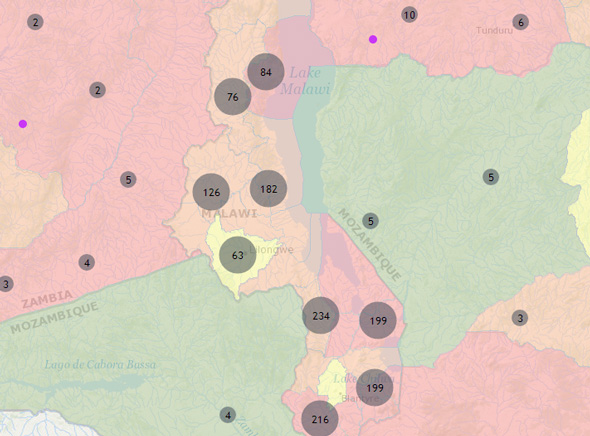-
CCAPS Looks to Map Climate-Related Aid in Africa
December 3, 2012 By Payal Chandiramani
Adapting to the effects of climate change is increasingly becoming an important component of many international development efforts. But how that integration occurs and what it looks like is an open question. To help answer that, the Climate Change and African Political Stability Program (CCAPS) at the University of Texas at Austin recently released a new database that for the first time tracks all the climate-related aid in one country – Malawi.
Comprised of geocoded datasets from CCAPS’s original research, the African Development Bank, and the World Bank, the project is the start of a continent-wide climate-coding effort. Malawi is the only country comprehensively covered right now, but sporadic data exists for others, and CCAPS is looking to expand its coverage next year.
Malawi’s Challenge – Not Unique
The effects of climate change are already apparent in Malawi and, with its reliance on rain-fed subsistence agriculture and a growing population, it is particularly vulnerable to them.
According to New Security Beat contributor Kathleen Mogelgaard, the country’s population is on pace to grow from 15 million people today to between 45 and 55 million by mid-century; maize productivity is expected to decline by 20 percent by 2030; and one in five children are already undernourished.
In order to deal with the effects of climate change in poor countries like Malawi, the World Bank’s 2010 World Development Report projects that an additional $100 billion a year is required on top of current aid flows (which amount to about $150 billion annually).
CCAPS found that climate aid currently accounts for only one to two percent of all aid to Malawi.
The bulk of the climate-oriented activities were sponsored by the Norwegian Agency for Development Cooperation (47) and the U.K. Department for International Development (36), with capacity development being dominated by the European Union (422).
CCAPS methodology is unique because it classifies activities within a project, instead of the entire project as a whole. This is done because, according to the CCAPS Climate Codebook, “most projects have multiple objectives, some of which may be very different from the others, and therefore have very different climate adaptation impacts.”
What Is “Climate Aid”?
Rather than a single definition of climate aid, CCAPS defines it along a spectrum of four categories of varying relevancy:
- Ambiguous development (least beneficial to climate adaptation);
- General development (addresses human and environmental well-being but not explicitly driven by or directly relevant to climate change threats);
- Capacity development (enhances resilience to climate change but not explicitly carried out with that purpose in mind); and
- Climate-oriented development (most clearly designed to address climate issues).
The categories are also assigned values between 0 and 2, with 2 signifying the most explicitly designed with climate change adaptation in mind.
Of the 753 projects identified in Malawi over a 15 year period, 2,961 separate activities were climate coded, and 2,523 of these were geocoded. Of the geocoded data, 125 activities were categorized as “climate oriented” and 846 activities were labeled as “capacity development.” While there were only 9 activities classified as “ambiguous development,” a large proportion of all activities – 1,471 – fell under “general development.”
The methodology used to compile this dataset is transparent and rigorous, relying on documents about donor programs collected through the Malawian Government’s Aid Management Platform and direct contact with donors.
The datasets are presented in a web dashboard, alongside CCAPS’ other mapping projects, on armed conflict, climate vulnerability, and social conflict. The map can also be overlaid with poverty rates, GDP per capita, and population density data.
Beyond Malawi
Outside of Malawi, data on aid’s relevancy to climate change in Africa is largely missing at the moment.
But CCAPS has plans to expand. “Our goal is to generate more timely, detailed, and useful information on climate finance to Africa to better understand where resources are being effectively mobilized to address the continent’s vulnerability to climate change,” wrote Catherine Weaver, a lead researcher on the CCAPS program.
As its datasets grow to include aid projects from other major donors and cover more ground, the CCAPS dashboard could become an incredibly useful tool for donors, policymakers, and researchers looking to understand how climate change is being integrated into aid in Africa and where it might be needed most.
Sources: Climate Change and African Political Stability Program, World Bank.
Topics: adaptation, Africa, agriculture, climate change, development, environment, Eye On, featured, Malawi, population, World Bank
 A Publication of the Stimson Center.
A Publication of the Stimson Center.



